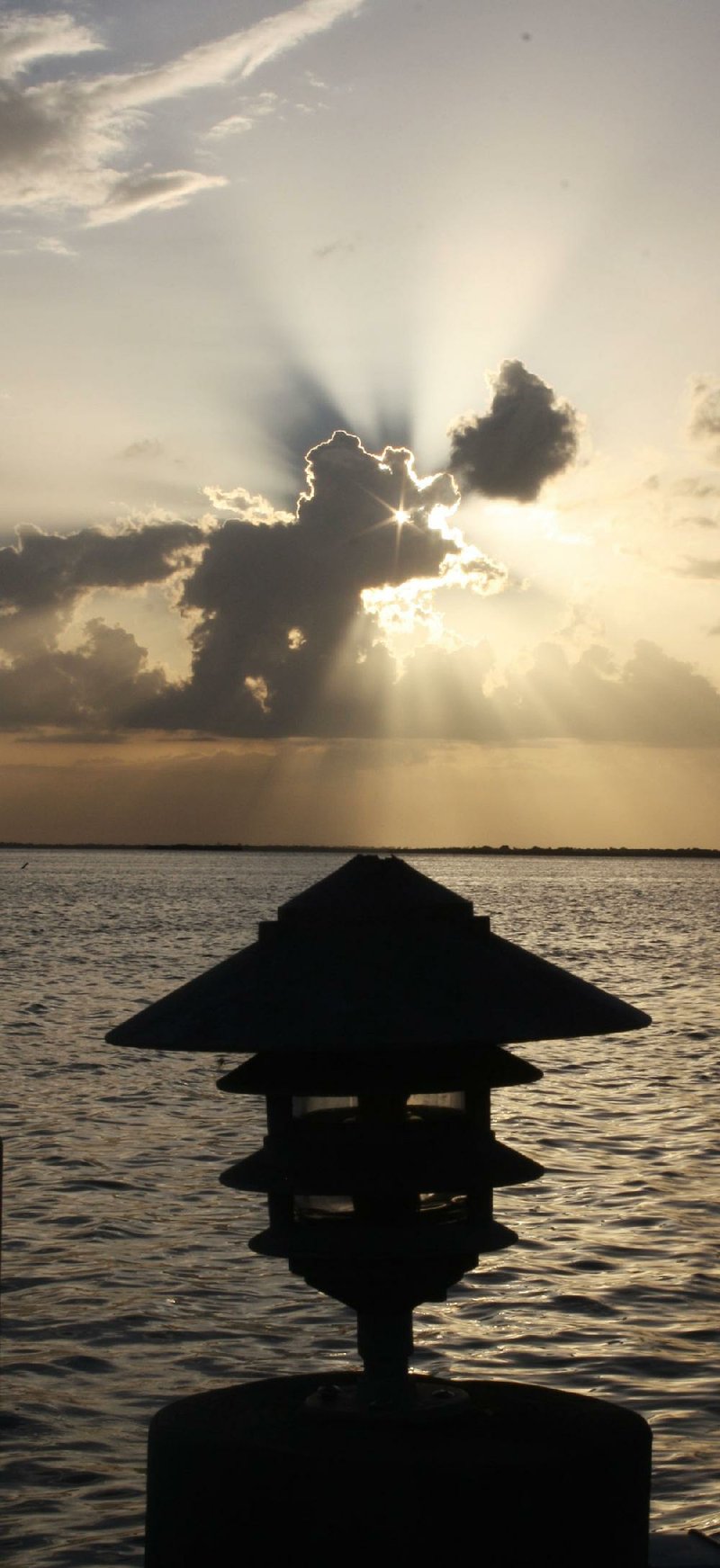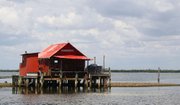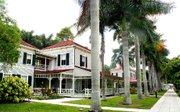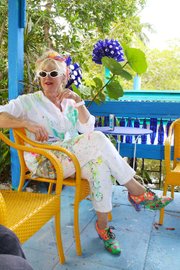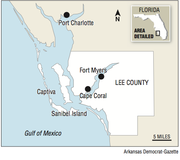FORT MYERS, Fla. -- Cars might be optional equipment when visiting southwest Florida's coast, but boats are essential.
In May, my wife, Laura, and I left Little Rock in a thunderstorm so fierce that it delayed our flight's departure. A few hours later, the emerald waters of Florida's west coast emerged through puffy clouds like a sun-kissed revelation. As our aircraft banked toward Southwest Florida International Airport, our tilted window gave us a direct view of the beachfront. Boats were as thick as ants on a hill.
If you go
You can find lodging to accommodate many tastes and budgets in the Fort Myers/Sanibel Island area, but two of my favorites are Tarpon Lodge and ’Tween Waters Island Resort.
Built in 1926, Tarpon Lodge preserves the aura of a traditional South Florida fishing camp with its whitewashed wooden construction. Rooms are cool, airy and well appointed with amenities that include a small refrigerator, but there are no landline telephones in the rooms.
Waterview rooms have balconies that overlook Pine Island Sound. Cottages are also available, as is a boathouse for large groups. Rates are available at tarponlodge.com or (239) 283-3999.
The Tarpon Lodge Restaurant is an experience in fine dining and features an impressive menu of seafood and steaks, as well as sumptuous daily specials. Our server, Frankie, is a master of performance art. He enhanced a fantastic dining experience, and that opinion is reflected on many online reviews.
’Tween Waters Inn Island Resort on Captiva Island is a more energetic, contemporary destination with considerably more traffic. Visitors can choose cozy cottages, suites, studios or guest rooms.
Studios are spacious lodgings that include partial kitchen with dishes and utensils, refrigerator and coffeemaker, television, walk-in shower and screened balconies. The latter is important if you want to sit on the balcony after dark.
’Tween Waters also offers fine dining at its excellent Captiva House Restaurant, as well as a full-service marina, spa and gift shop.
Rates are available at tween-waters.com or (800) 223-5865.
Tourism info: leevcb.com
"We are a water culture," says Shelley Crant, public relations manager for the Lee County Convention and Visitor Bureau. "The lifestyle here revolves around water."
It certainly does, from diet to decoration. Fresh seafood is abundant and available in any form. Seashells adorn every dwelling, the most conspicuous being a home on Pine Island whose exterior siding is composed entirely of shells.
Laura and I rented a car, primarily to catch boats that go to places that cars can't go. South Captiva Island, Cabbage Key and Cayo Costa State Park are a few of the barrier islands in the Fort Myers area that are accessible only by water, although South Captiva also has a landing strip for small aircraft.
Fort Myers-Sanibel has an entirely different vibe from Panama City/Fort Walton. In fact, it's entirely different from that of St. Petersburg, Clearwater and Tampa a bit farther north. It's more laid-back, with an unaffected, more native ambience. It lacks the go-go kitsch of northwest Florida and the noisy bustle of St. Petersburg-Clearwater-Tampa.
Lee County welcomes development, of course, but on its own terms. For example, it is unlawful on Sanibel Island to construct any building taller than the height of the tallest palm tree. There are also no traffic lights on Sanibel Island.
You can have your salt water any way you like it in Fort Myers/Sanibel. The Gulf of Mexico pounds the western shores with waves and wind, but its gentle backwaters caress the eastern shores and their mangrove hems. The shallow bays are less than 6 feet deep in most places, and aquatic grasses carpet the sea floor.
Manatees come to these nursery waters to raise their young in the spring and early summer. Laura and I caught fleeting glimpses from a distance. Bottlenose porpoises also frolic and hunt near any boat that moves.
Sea turtles nest on the Gulf-side beaches. Numerous nests were already marked and roped off in early May. We were delighted to see our first sea turtle in the surf while fishing offshore for mackerel.
Many resorts and marinas in the area rent kayaks, and that's an ideal conveyance for exploring the gentle waters of the bays and sounds between the mainland and the islands. Take an extra memory card for your camera, because you will take a lot of photos of sea life, bird life, flowers and fruit.
Oh, the fruit! It grows everywhere. Laura and I devoured fresh mangoes that fell on the ground at the Calusa Heritage Trail near Bokeelia, and they were much sweeter than the grocery store variety. Coconuts, dates and bananas are abundant, too.
Naturalists flock to southwest Florida to view its diverse array of seabirds. The best place for a day of concentrated birdwatching is at the J.N. "Ding" Darling National Wildlife Refuge, on the north side of Sanibel Island. Visitors can walk the trails or travel the 8-mile Wildlife Drive that winds through the refuge to see some of the 250 bird species that inhabit the area. Guided tours are also available with a volunteer naturalist.
The Sanibel Island Lighthouse, on the east end of Sanibel Island, overlooks an excellent beach for wading and swimming. Shaded by live oaks, the area near the lighthouse is popular for weddings.
Cayo Costa State Park is another excellent destination for birding, fishing and beach-combing. Laura and I took an hour-long ride on the Tropic Star from Jug Creek Marina at Bokeelia with a young couple from Munich. Fare was $32 per person round trip, plus $6 for parking. It's a slow boat because the water is so shallow.
"If we sink, just stand up," our pilot said.
Our gregarious ferryman said that his 26 years with the U.S. Coast Guard taught him to be an expert pilot in the tight, narrow channels of Charlotte Harbor and Pine Island Sound. Despite technological advances, piloting is still largely done the old-fashioned way.
"With GPS and everything else we have, it's still, 'Get even with the big house and hang a right,'" he said.
Contradictions permeate this community. Cayo Costa, for example, is sprinkled with multimillion-dollar mansions, but there's no commercial electrical service. The houses are powered by propane or gasoline generators, and by solar power.
We ended every day with beach strolls that filled our daypacks with seashells. Shell collecting is popular here, and pocket guides are available to identify the 400 different kinds of shells you'll encounter. You can keep any shell that's not occupied by a live mollusk.
Nights we spent stargazing on the beach.
All together, it was an incomparable immersion in a most remarkable water culture.
THINGS TO DO
The islands near Fort Myers offer nightlife to suit any lifestyle, but there's also a lot to do during the day.
History buffs will enjoy the Calusa Heritage Trail, which is across the road from Tarpon Lodge on Pine Island. Maintained by the Florida Museum of Natural History, it is a 3,700-foot interpretive walkway through the mounds, canals and other features of a major pre-Columbian settlement of the Calusa tribe. It is similar to our own Toltec Mounds State Park.
Nearby is the 920-acre Pine Island Flatwoods Preserve. Owned and maintained by Lee County Conservation 20/20 and the Daniel Captiva Conservation Foundation, it is a model for the proper use of prescribed fire in restoring Florida's savannas.
Of course, no trip to Fort Myers is complete without a visit to the Edison & Ford Winter Estates. This 25-acre attraction is one of the nation's Top 10 most visited historic sites and displays the winter quarters for Thomas Edison and Henry Ford. The museum is packed with exhibits including many of Edison's inventions, as well as Model T and Model A Ford vehicles and an immaculately restored Ford flathead V-8 engine.
For more information, visit edisonfordwinterestates.org.
ARTISTS' MAGNET
A place with as much color and personality as Sanibel and neighboring islands is a magnet for artists.
Matlacha (pronounced Matt-la-SHAY) is a former commercial fishing village turned artist colony. Its most colorful personality is Leoma Lovegrove, the Muse of Matlacha. It's not a stretch to say she inspired the Ms. Frizzle character from the Magic School Bus children's series.
Lovegrove said she is often asked not to attend her own shows because her presence is "disruptive."
Her studio is a quirky crucible of pop art and artistic repurposing. Her walls are covered with portraits of the Beatles and other pop figures. Every colored bottle, ashtray and metal container that has ever entered her orbit has been likely been converted to an objet d'art. Even the trunks of her palm, coconut and banana trees are brightly painted.
"I'm an artist of environment," Lovegrove said. "Whatever's around me is what I'm going to paint."
She's also a savvy marketer with a formidable international reputation. Her portrait of Richard Branson hangs in his corporate office and her portrait of former president Jimmy Carter hangs in Carter's presidential library.
Lovegrove's studio is one of the most fascinating stops in the area. If she's present, so much the better.
For more information, visit leomalovegrove.com.
Travel on 06/14/2015
